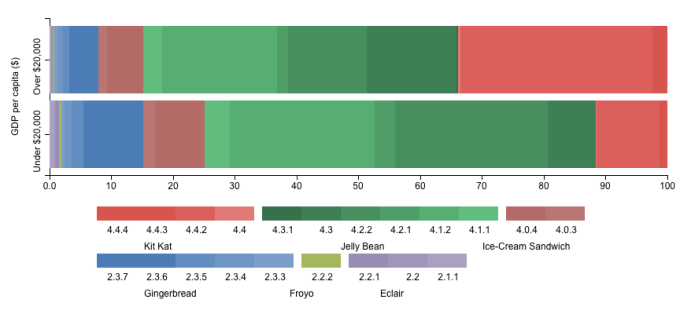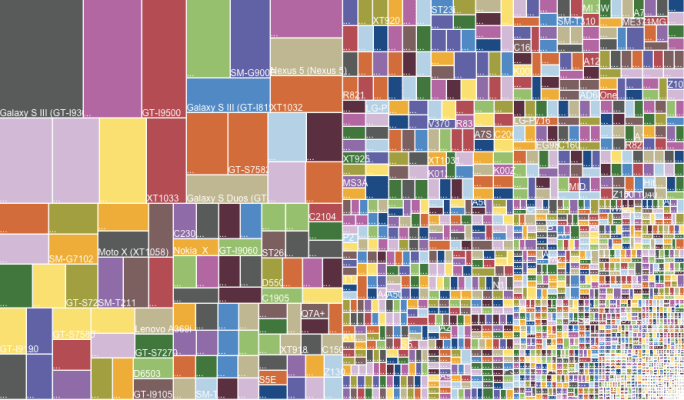Growing Android fragmentation — or device diversity if you prefer — has been visualized in a new report by crowdsourced cell phone signal startup OpenSignal, which has surveyed 682,000 devices to build its annual peek at Google’s mobile OS ecosystem.
While OpenSignal’s mid-2012 OpenSignal survey recorded just under 4,000 different Android devices using its software over the prior 12 months, its 2013 report saw that figure grow almost 3x, to near 12,000. This year’s report shows continued expansion in the number of different Android devices in use, with the survey identifying 18,796 unique Android devices — a growth rate of around 60 percent, year on year.
The data also shows a slight dip in dominance for leading Android OEM Samsung, which takes a 43 percent share of the Android device market over the surveyed period, vs. 47.5 percent in the year ago report. That tallies with a slowdown in Samsung’s growth this year that has taken a little of the sheen off the phone giant.
Interestingly Nokia’s abortive attempt to turn Android into a Trojan horse for Microsoft services — by forking Android to make the Nokia X software platform — cuts itself a small but visible chunk of the overall pie. Roughly about a quarter of the share garnered by Google’s Nexus-branded devices, or about half the size of fast growing Android startup Xiaomi on the brand fragmentation view.
All of which is academic now, of course, given that the new owner of Nokia’s device division, Microsoft, has decided to ditch the strategy in favour of focusing its efforts on its Windows Phone OS.
OpenSignal’s data pegs uptake of the latest version of Android — KitKat — at around a fifth (20.9 percent) of Android users. That’s down notably on the 2013 figure for users on the (then) latest version of Android. Back in mid-2013 Jelly Bean usage stood at more than a third (37.9 percent).
Increasing device diversity/fragmentation means developers choosing to target the top 10 Android devices are addressing a smaller proportion of overall users (although the overall size of the Android pie is growing). OpenSignal notes that last year the ten most popular Android devices in the market represented about a fifth (21 percent) of the devices out there, vs this year’s top ten representing 15 percent.
The survey also flags up the link between increased OS version fragmentation and decreased GDP/capita — which, from a developer point of view, suggests it’s more challenging monetizing apps in emerging markets because devices are more spread/fragmented across less recent Android versions.
OpenSignal’s data indicates that over a third (35 percent) of Android devices in countries with GDP/capita of greater than $20,000 are on the latest version of Android vs just 12 percent in less economically developed countries.

The full 2014 OpenSignal Android ecosystem report can be viewed here.
